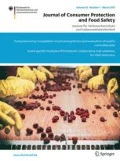Abstract
In recent years, new techniques in molecular biology have spread in mainstream research and development of genetically modified organisms. These techniques differ from the classical approach of adding an exogenous gene to the genome of a target organism to obtain a desired phenotype as they aim at modifying endogenous genes or gene expression. Of greatest importance to regulatory administration in BVL are techniques using RNA-Interference and genome editing methods. RNA-Interference techniques aim at suppression of endogenous gene activity, while genome editing techniques allow complex modifications of one or several genes. With these methods the focus of action switches from the insertion of protein-encoding DNA towards the introduction of regulatory small RNA molecules.


Similar content being viewed by others
References
Bolognesi R, Ramaseshadri P, Anderson J, Bachman P, Clinton W, Flannagan R, Ilagan O, Lawrence C, Levine S, Moar W, Mueller G, Tan J, Uffman J, Wiggins E, Heck G, Segers G (2012) Characterizing the mechanism of action of double-stranded RNA activity against western corn rootworm (Diabrotica virgifera virgifera LeConte). PLoS One 7(10):e47534
Bonfim K, Faria JC, Nogueira EO, Mendes EA, Aragao FJ (2007) RNAi-mediated resistance to Bean golden mosaic virus in genetically engineered common bean (Phaseolus vulgaris). Mol Plant Microbe Interact 20(6):717–726
Braig HR, Yan G (2002) The spread of genetic constructs in natural insect populations. In: Letourneau DK, Burrows BE (eds) Genetically engineered organisms: assessing environmental and human health effects. CRC Press, Boca Raton, pp 251–314
Burt A (2003) Site-specific selfish genes as tools for the control and genetic engineering of natural populations. Proc Biol Sci 270(1518):921–928
Burt A, Koufopanou V (2004) Homing endonuclease genes: the rise and fall and rise again of a selfish element. Curr Opin Genet Dev 14(6):609–615
Chevalier BS, Stoddard BL (2001) Homing endonucleases: structural and functional insight into the catalysts of intron/intein mobility. Nucl Acids Res 29(18):3757–3774
Day AG, Bejarano ER, Buck KW, Burrell M, Lichtenstein CP (1991) Expression of an antisense viral gene in transgenic tobacco confers resistance to the DNA virus tomato golden mosaic virus. Proc Natl Acad Sci USA 88(15):6721–6725
DiCarlo JE, Chavez A, Dietz SL, Esvelt KM, Church GM (2015) RNA-guided gene drives can efficiently and reversibly bias inheritance in wild yeast. bioRxiv. doi:10.1101/013896
EFSA (2006) Opinion of the Scientific Panel on genetically modified organisms [GMO] on an application (Reference EFSA-GMO-UK-2005-14) for the placing on the market of genetically modified potato EH92-527-1 with altered starch composition, for production of starch and food/feed uses, under Regulation (EC) No 1829/2003 from BASF plant science. EFSA J (324):1–20
Esvelt KM, Smidler AL, Catteruccia F, Church GM (2014) Concerning RNA-guided gene drives for the alteration of wild populations. Elife 3:e03401
Fire A, Albertson D, Harrison SW, Moerman DG (1991) Production of antisense RNA leads to effective and specific inhibition of gene expression in C. elegans muscle. Development 113(2):503–514
Fire A, Xu S, Montgomery MK, Kostas SA, Driver SE, Mello CC (1998) Potent and specific genetic interference by double-stranded RNA in Caenorhabditis elegans. Nature 391(6669):806–811
Gantz VM, Bier E (2015) Genome editing. The mutagenic chain reaction: a method for converting heterozygous to homozygous mutations. Science 348(6233):442–444
Hartung F, Schiemann J (2014) Precise plant breeding using new genome editing techniques: opportunities, safety and regulation in the EU. Plant J 78(5):742–752
Hsu PD, Lander ES, Zhang F (2014) Development and applications of CRISPR-Cas9 for genome engineering. Cell 157(6):1262–1278
Huvenne H, Smagghe G (2010) Mechanisms of dsRNA uptake in insects and potential of RNAi for pest control: a review. J Insect Physiol 56(3):227–235
Jones HD (2015) Regulatory uncertainty over genome editing. Nature plants vol 1. Macmillan Publishers
Oye KA, Esvelt KM (2014) Gene drives raise dual-use concerns–response. Science 345(6200):1010–1011
Oye KA, Esvelt K, Appleton E, Catteruccia F, Church G, Kuiken T, Lightfoot SB, McNamara J, Smidler A, Collins JP (2014) Biotechnology. Regulating gene drives. Science 345(6197):626–628
Price DR, Gatehouse JA (2008) RNAi-mediated crop protection against insects. Trends Biotechnol 26(7):393–400
Puchta H, Fauser F (2014) Synthetic nucleases for genome engineering in plants: prospects for a bright future. Plant J 78(5):727–741
Ribeiro JM, Kidwell MG (1994) Transposable elements as population drive mechanisms: specification of critical parameter values. J Med Entomol 31(1):10–16
Romer S, Lubeck J, Kauder F, Steiger S, Adomat C, Sandmann G (2002) Genetic engineering of a zeaxanthin-rich potato by antisense inactivation and co-suppression of carotenoid epoxidation. Metab Eng 4(4):263–272
Tuvesson ST, Gilen J, Weich S, Benesfelt J, Lennefors B, Van Roggen P (2009) Transgenic sugar beet event gm rz13. US 13/140,878. [US20120144516 A1]
Visser RG, Somhorst I, Kuipers GJ, Ruys NJ, Feenstra WJ, Jacobsen E (1991) Inhibition of the expression of the gene for granule-bound starch synthase in potato by antisense constructs. Mol Gen Genet 225(2):289–296
Windbichler N, Menichelli M, Papathanos PA, Thyme SB, Li H, Ulge UY, Hovde BT, Baker D, Monnat RJ Jr, Burt A, Crisanti A (2011) A synthetic homing endonuclease-based gene drive system in the human malaria mosquito. Nature 473(7346):212–215
Zentrale Kommission für die Biologische Sicherheit (2012) Position statement of the ZKBS on new plant breeding techniques. http://www.bvl.bund.de/SharedDocs/Downloads/06_Gentechnik/ZKBS/02_Allgemeine_Stellungnahmen_englisch/05_plants/zkbs_plants_new_plant_breeding_techniques.pdf?__blob=publicationFile&v=2
Zhang J, Khan SA, Hasse C, Ruf S, Heckel DG, Bock R (2015) Pest control. Full crop protection from an insect pest by expression of long double-stranded RNAs in plastids. Science 347(6225):991–994
Author information
Authors and Affiliations
Corresponding author
Additional information
The Journal of Consumer Protection and Food Safety (JVL) is published by the Federal Office of Consumer Protection and Food Safety. This article has been published on the occasion of the JVL’s 10th anniversary.
Rights and permissions
About this article
Cite this article
Schenkel, W., Leggewie, G. New techniques in molecular biology challenge the assessment of modified organisms. J. Verbr. Lebensm. 10, 263–268 (2015). https://doi.org/10.1007/s00003-015-0958-4
Published:
Issue Date:
DOI: https://doi.org/10.1007/s00003-015-0958-4




